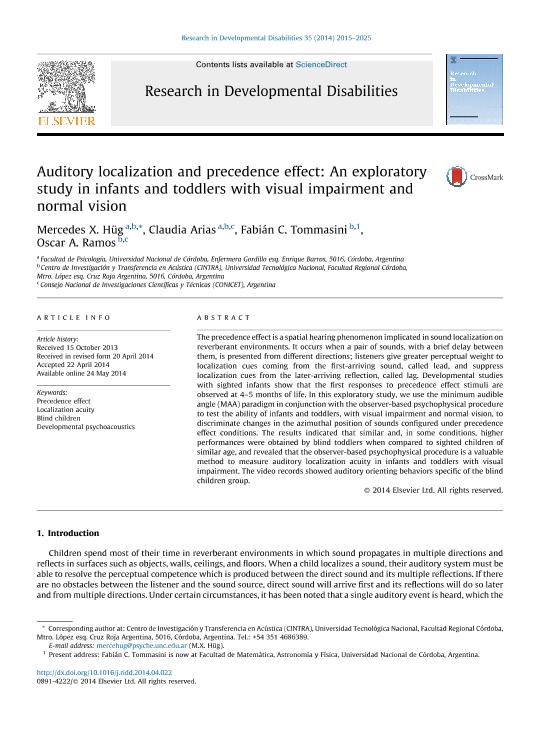Artículo
Auditory localization and precedence effect: An exploratory study in infants and toddlers with visual impairment and normal vision
Fecha de publicación:
09/2014
Editorial:
Elsevier Inc
Revista:
Research in Developmental Disabilities
ISSN:
0891-4222
e-ISSN:
1873-3379
Idioma:
Inglés
Tipo de recurso:
Artículo publicado
Clasificación temática:
Resumen
The precedence effect is a spatial hearing phenomenon implicated in sound localization on reverberant environments. It occurs when a pair of sounds, with a brief delay between them, is presented from different directions; listeners give greater perceptual weight to localization cues coming from the first-arriving sound, called lead, and suppress localization cues from the later-arriving reflection, called lag. Developmental studies with sighted infants show that the first responses to precedence effect stimuli are observed at 4-5 months of life. In this exploratory study, we use the minimum audible angle (MAA) paradigm in conjunction with the observer-based psychophysical procedure to test the ability of infants and toddlers, with visual impairment and normal vision, to discriminate changes in the azimuthal position of sounds configured under precedence effect conditions. The results indicated that similar and, in some conditions, higher performances were obtained by blind toddlers when compared to sighted children of similar age, and revealed that the observer-based psychophysical procedure is a valuable method to measure auditory localization acuity in infants and toddlers with visual impairment. The video records showed auditory orienting behaviors specific of the blind children group.
Archivos asociados
Licencia
Identificadores
Colecciones
Articulos(CCT - CORDOBA)
Articulos de CTRO.CIENTIFICO TECNOL.CONICET - CORDOBA
Articulos de CTRO.CIENTIFICO TECNOL.CONICET - CORDOBA
Citación
Hug, Mercedes Ximena; Arias, Claudia; Tommasini, Fabián Carlos; Ramos, Oscar Alberto; Auditory localization and precedence effect: An exploratory study in infants and toddlers with visual impairment and normal vision; Elsevier Inc; Research in Developmental Disabilities; 35; 9; 9-2014; 2015-2025
Compartir
Altmétricas




